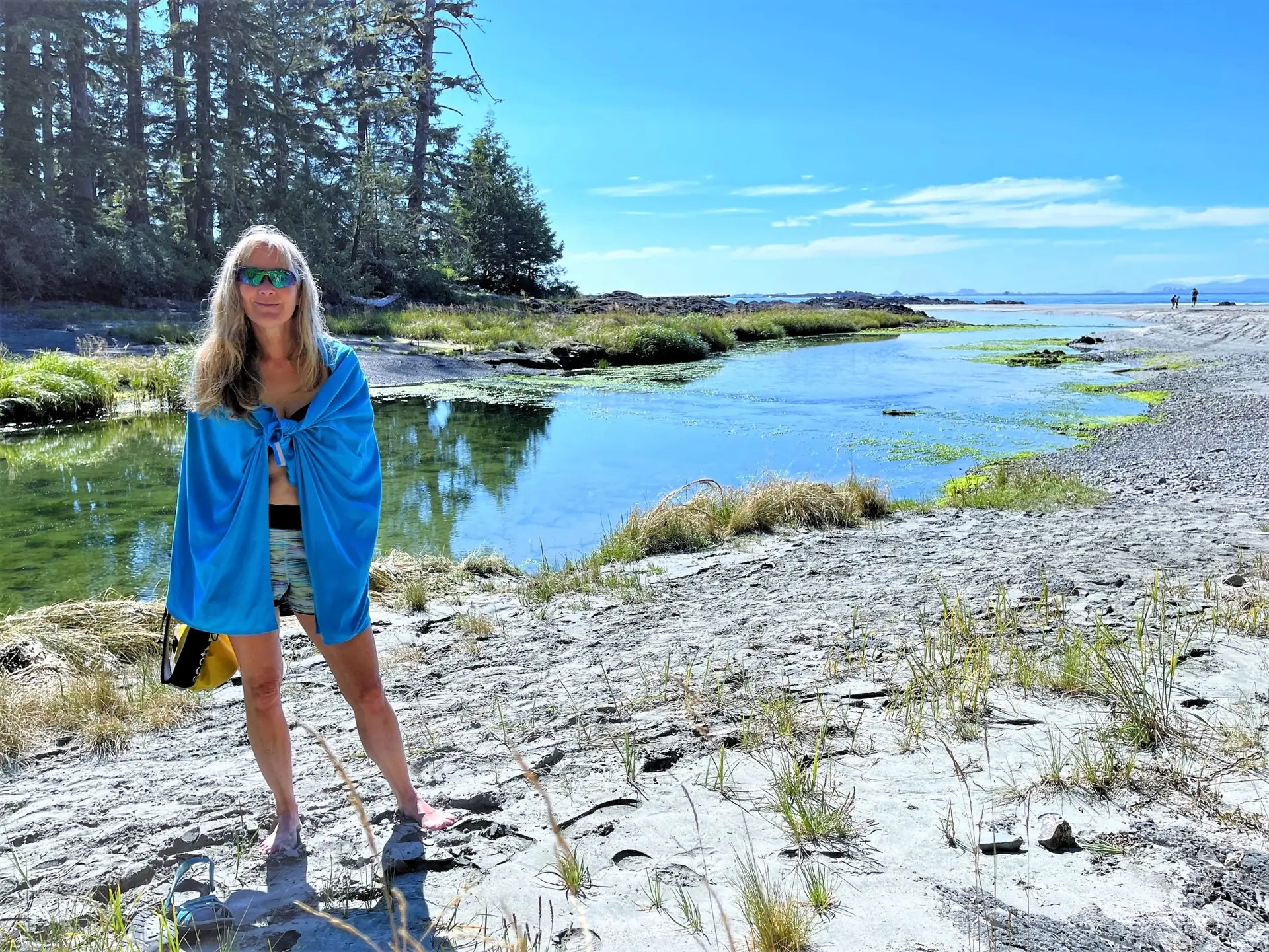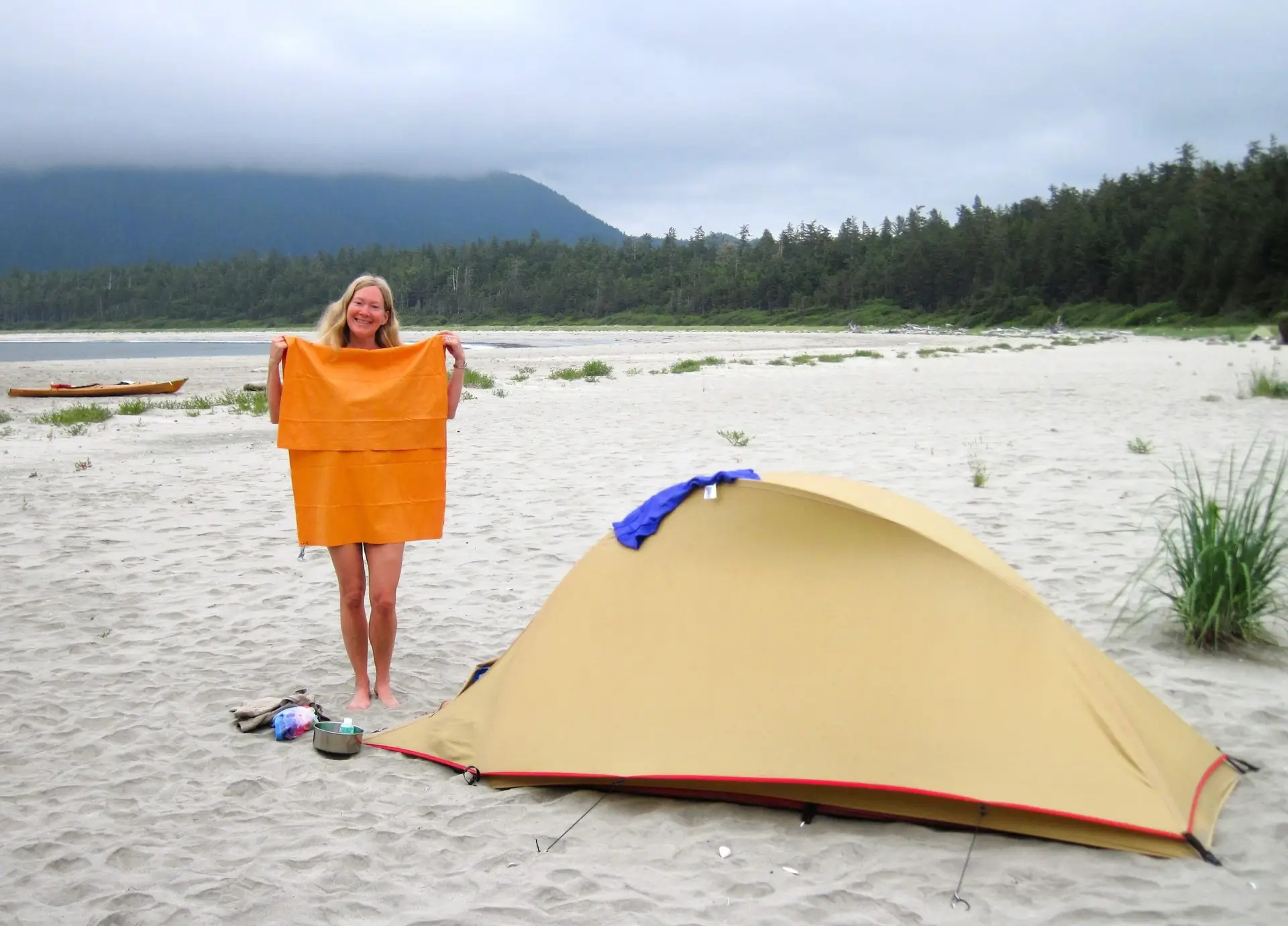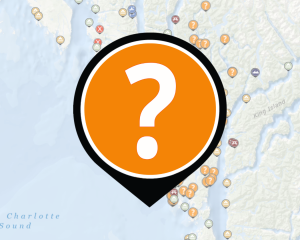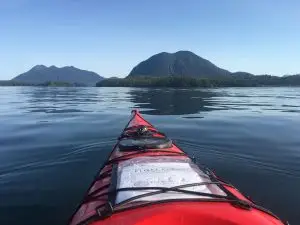“Back up! Back up towards the logs!” I instruct Julee, waving her backward with one hand while holding a camera in the other.
I’m still dripping wet from an ocean swim and shampoo at one of our favourite Vancouver Island beaches. It’s a quintessential West Coast beach, with huge driftwood logs tossed like kindling along the high tide line forming a wall backed by densely-packed evergreens. Everything looks blurry without my prescription glasses, but I feel at home here, so I’m not worried about the large black Labrador retriever ambling along the logs behind Julee. I assume its owner has landed on the beach nearby.
Julee puts down the sea soap she’s planning to use for her ocean bath and backs up agreeably for the photo.
As she does, a movement behind her catches Julee’s eye. She turns to discover that she’s uncomfortably close to a bear — that her boyfriend has been telling her to get closer to!
“Hey, Mister Bear!” she says in a deliberately deep voice, loud enough for both the bear and I to hear. She stands her ground and watches the bear’s response. From her work as a biologist in the BC Forest Service, she knows the official bear safety advice, which begins with observing the animal. Is the bear showing noisy bravado or silent, serious, predatory intensity? In this case, the bear completely ignores us and continues on its way.
After the black bear disappears, I try to justify to a still upset Julee why I thought it was only a dog.
Later that same paddling trip, we secure our food at camp and walk around a headland to take a nap out of the wind on a sandy beach. We wake to find bear tracks passing ten meters from where we’d been sleeping. “Those weren’t there before, were they?” we wonder, incredulous at our potential vulnerability.
Judging by the straight path of the tracks in the sand, if the bear did pass while we napped, it had given us a wide berth. Again, this bear seemed to be just minding its own business.
Any sea kayaker venturing along the wild BC coast has probably been vexed by two issues: how to bathe in the wilderness, and how to avoid bear problems. Here are a few tips and stories from our experiences with both. We are not bear experts and have compiled the advice in this article from a variety of reputable sources. Interested readers should do their own research.
Wild Bathing Tips
Many of our most joyful paddling experiences have involved swimming in wild surf and bathing naked in the rock pools, lakes, and rivers lining the coast. Bathing in the wild is an exhilarating experience. Cold water immersion makes every nerve tingle, leaving you feeling truly alive. And it’s good for you: it has been shown to boost mental health, reduce inflammation, and support longevity, as publicized by enthusiasts like Wim Hof.
The thrill of bathing in a wild river or lake is even greater when you know you’re sharing a habitat with bears, wolves, or cougars. You lather up your vulnerable naked flesh with all your senses on high alert, constantly scanning your surroundings. Every rustle of the brush or unexpected splash makes your heart quicken. You are keenly reminded of your natural place in the world: dominant omnivore, but also prey if you’re not careful. This watchfulness adds an intensity to bathing in the wild that you simply never experience in your bathtub at home.
What to Pack
If your kayaking plans involve bathing in the wild, be sure to pack biodegradable sea or camp soap sold at most outdoor stores. Bring a pot or bowl so you can wash in ankle-deep water if you choose, and rinse off away from freshwater sources. For a warm shower, consider packing a black plastic shower bag that you can either let warm in the sun for a few hours or fill with water heated on your camp stove. A lightweight quick-dry (not cotton) towel will help you enjoy drying off day after day.
Pick A Spot
Pick a spot that appeals to you: waves to body surf, a serene beach, or perhaps a sheltered tide pool. They will all feel shockingly cold — this is British Columbia, not Hawaii. Pause to take in the sights, sounds, and smells of the natural world surrounding you. Approach the frigid water’s edge and steel yourself.
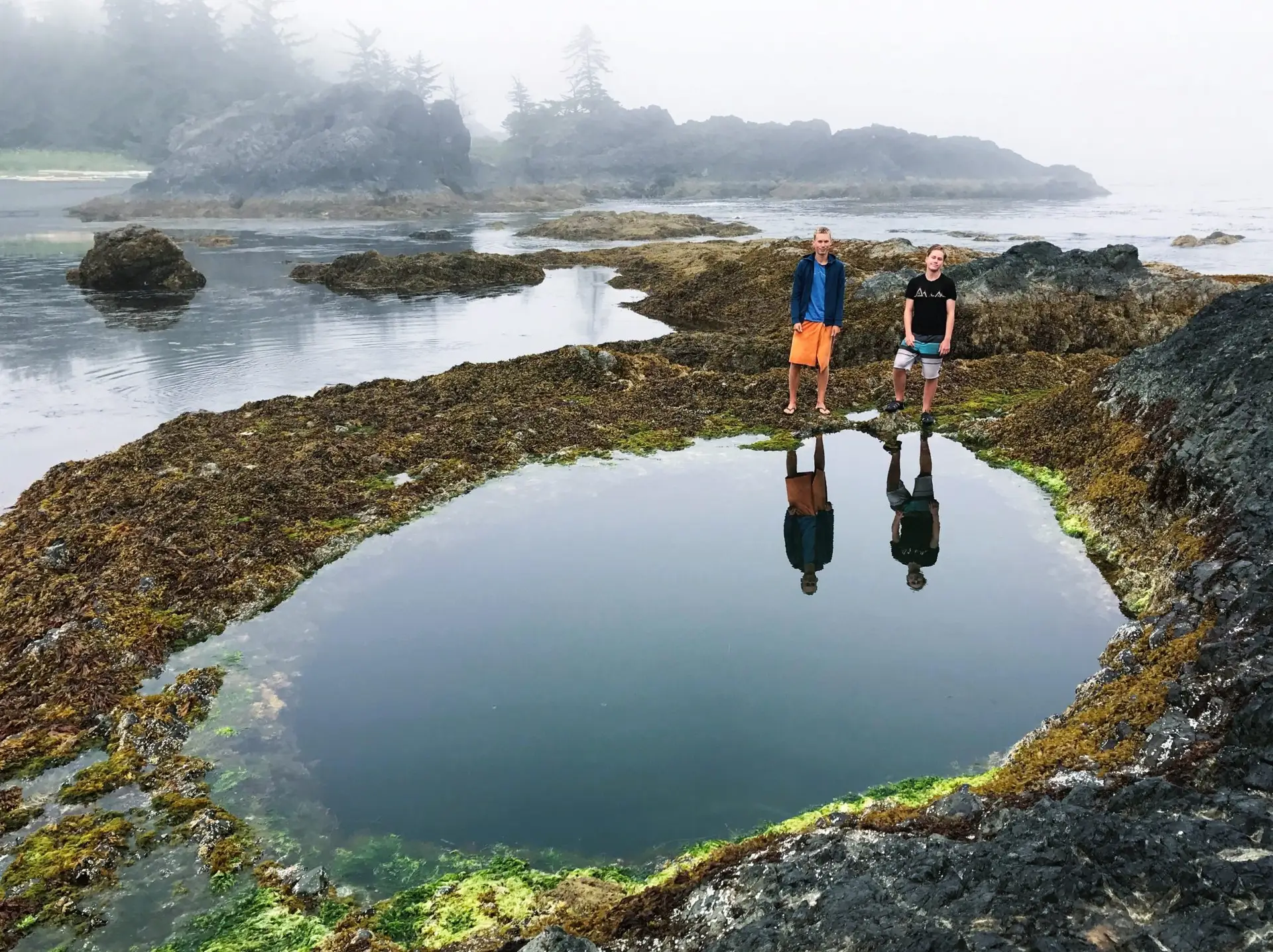
Wade or Dive In
As you debate whether to wade or dive in, remember this: wading prolongs the agony, while diving in is like ripping off a band-aid — a massive band-aid that covers your entire body. Either way, you’ll end up fully awake!
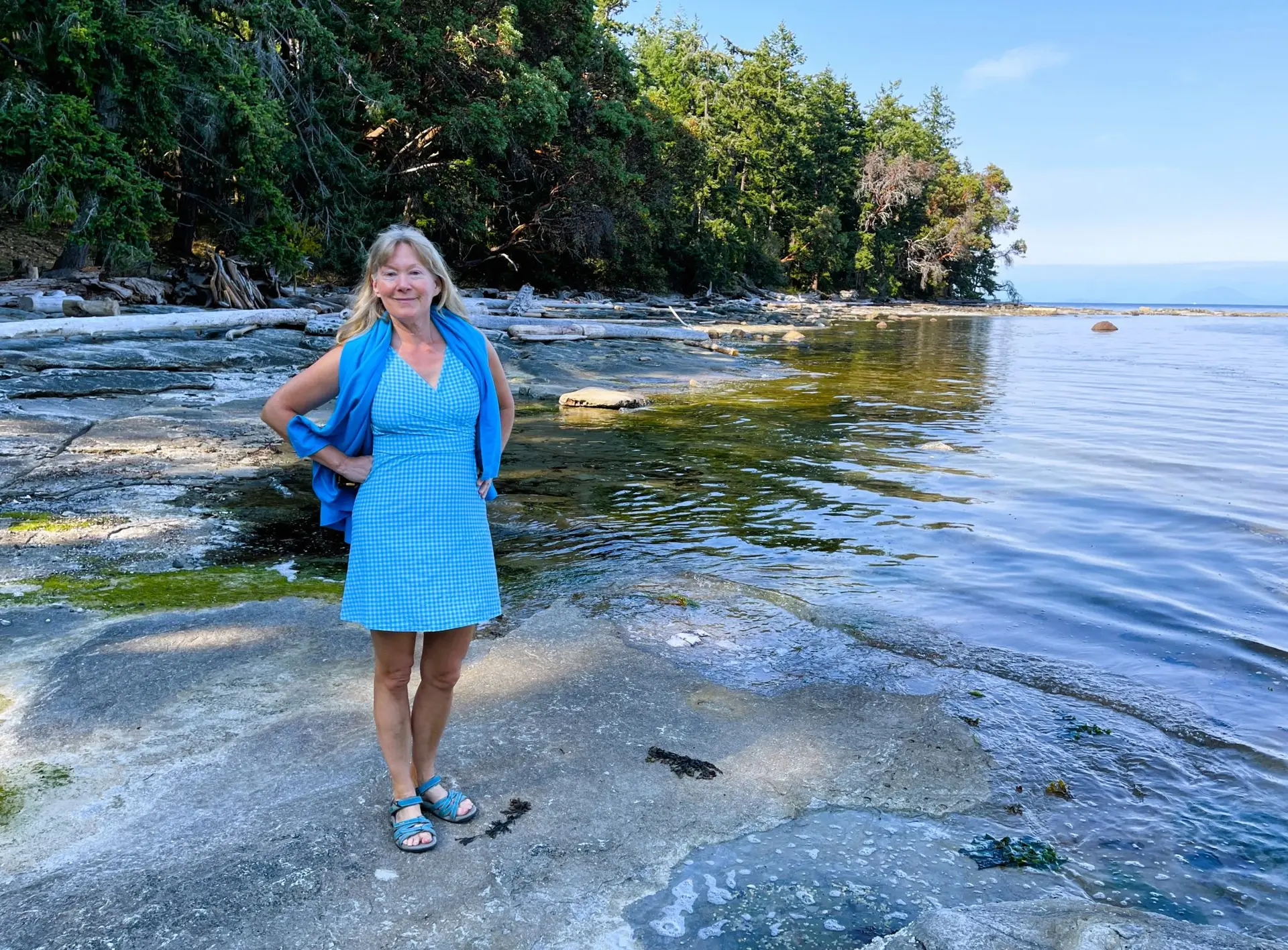
Wild Bathing with Children
For sheer exuberant, full-throated fun, it’s hard to beat swimming with kids in the wild. Yes, we do a parental check for dangers, yes our boys were strong swimmers from a young age, and yes I used to be a lifeguard, so the safety box has been ticked. Swimming in the wild is one of the few places where parents can encourage kids to frolic at full volume, knowing that noise helps steer predators away from camp!
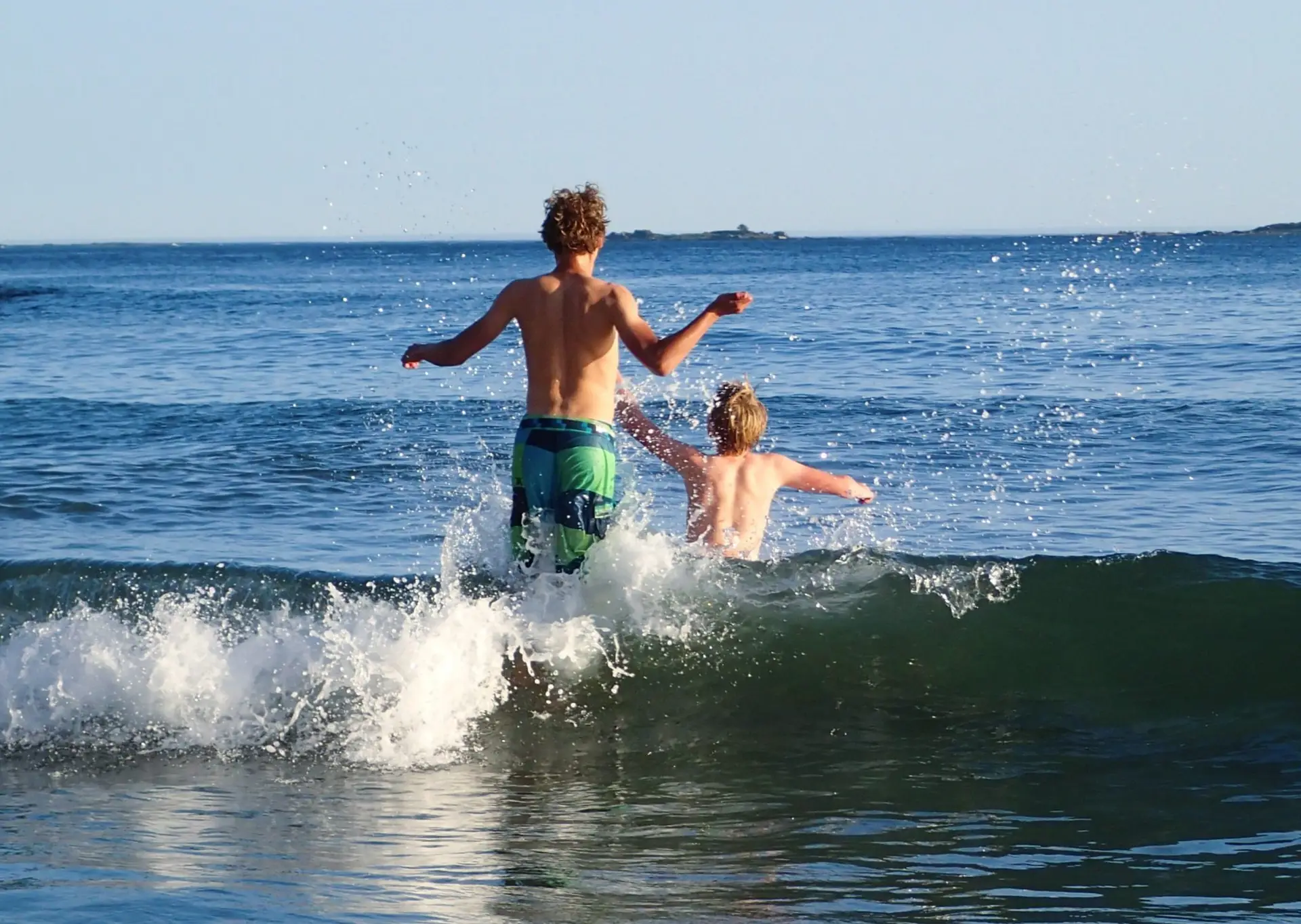
Putting it all together: “Woman Who Washes With Bears”
It was on our 600-km paddle from Bella Bella to Tofino that Julee first earned that nickname, at the very spot shown in the photo below. It had been days since she’d had a chance to rinse the salt water out of her hair so she was pleased to find a sizeable gravel pool where a mountain-fed stream flowed out to the beach.
As we approached the pool, I saw fresh bear tracks and plenty of scat. The sound of rustling in the nearby forest sent my heart racing. I clutched the bear spray while scanning the trees for signs of movement.
Julee, however, was determined not to miss the opportunity to wash in fresh water. She waded right in. For the next ten minutes, I stood guard with the bear spray while Julee lathered her long hair with sea soap, pre-rinsing with a pot of water away from the pool. Then she laid down to float on her back for a final rinse.
When it was my turn to wash, I dipped one foot in the rock pool, shivered at the shock of the cold, and then tiptoed daintily until the water was barely above my knees. I bent over to dip my head in the water, then with lightning speed washed my hair, underarms, and groin with sea soap.
We never did see the bear that left tracks around our wild swimming pool.
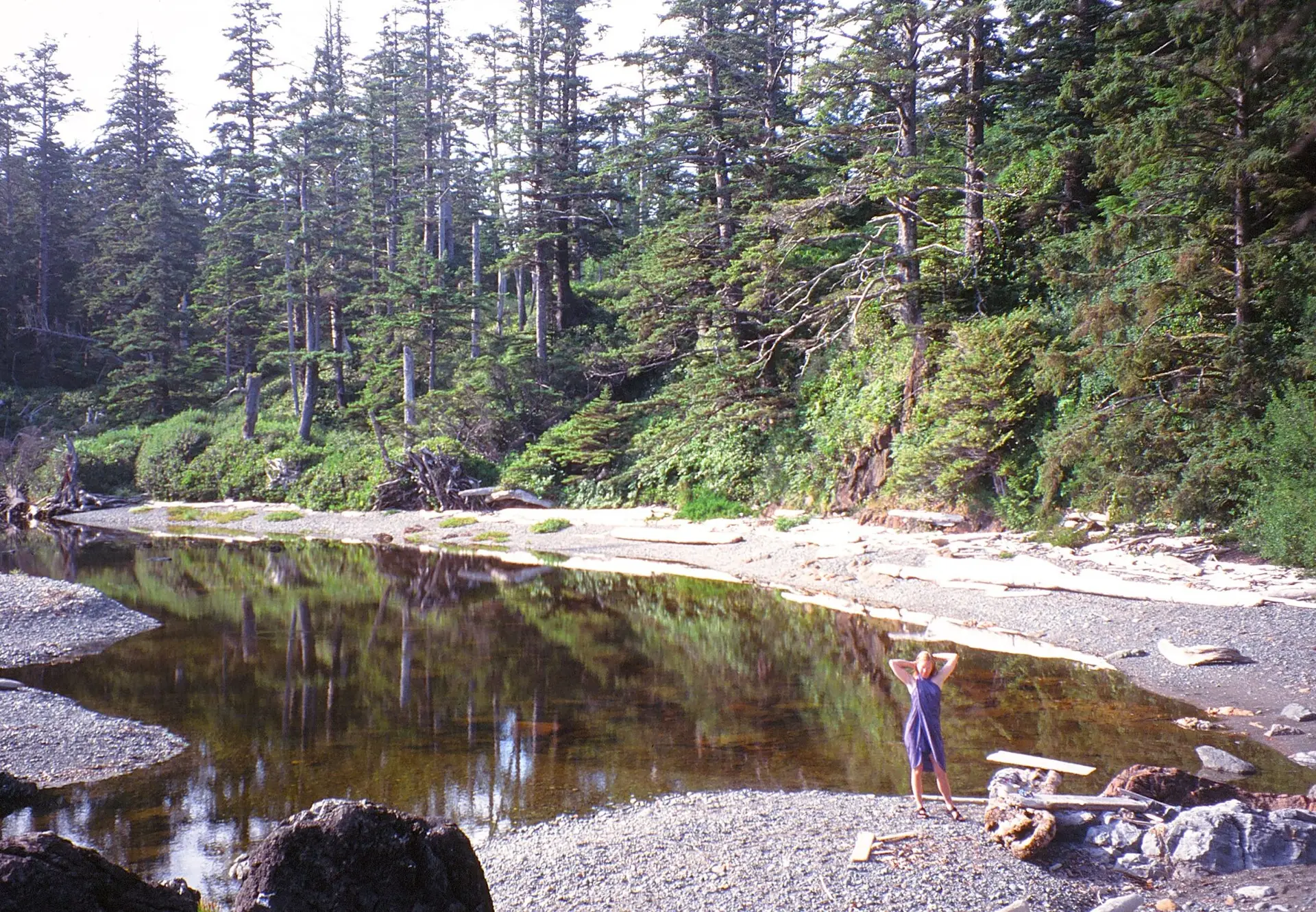
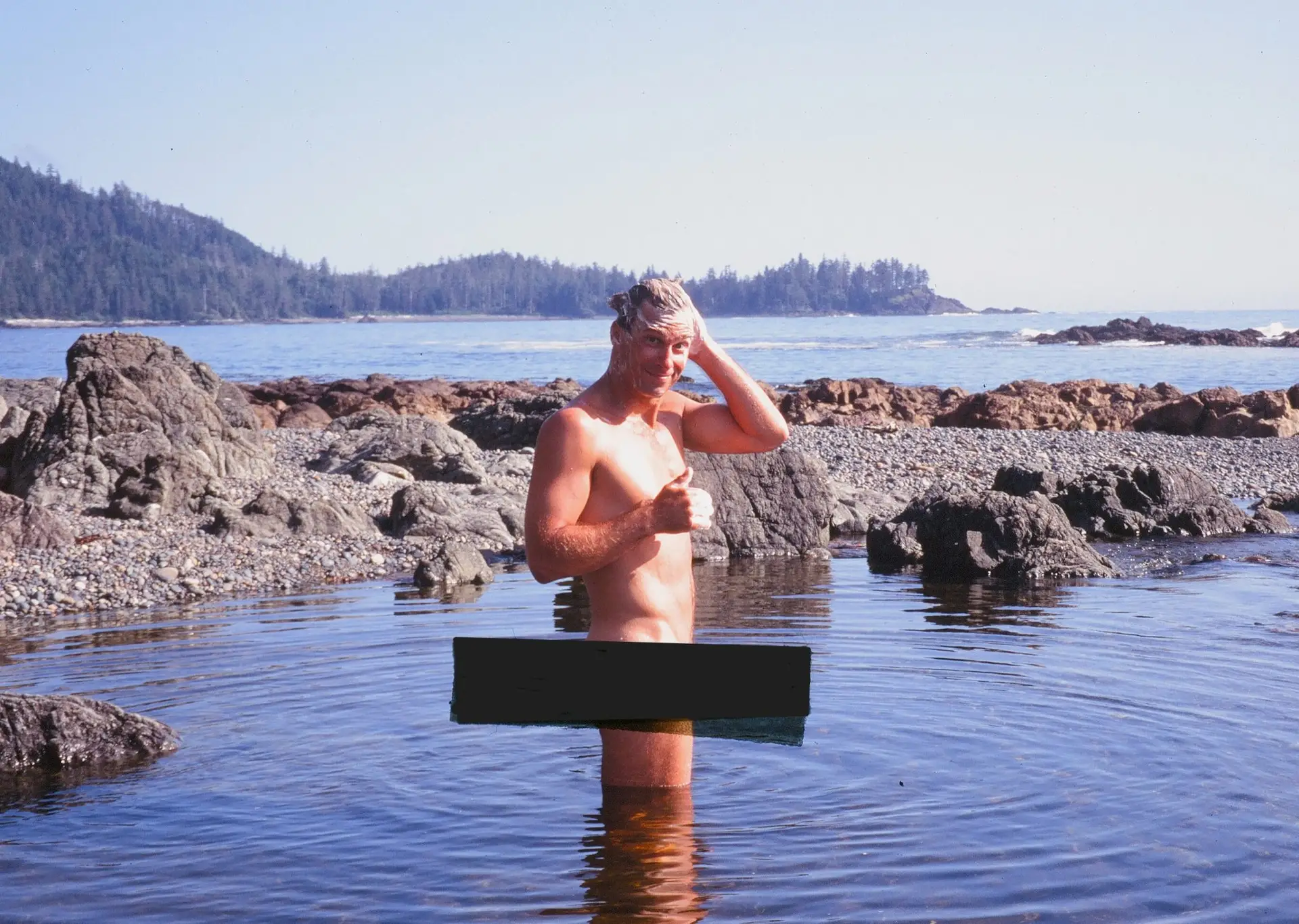
Bear Safety Tips For Sea Kayaking In British Columbia
Our aim as kayakers should be to peacefully co-exist with bears and other wildlife. By preparing properly, maintaining a clean campsite, announcing yourself while hiking, carrying bear spray, and knowing how to act if you do see a bear, you can significantly reduce the risks to yourself and the resident wildlife.
Preparation
Heading into bear country? Check park websites for recent bear activity, and respect closures. Reach out to the local First Nation for guidance. Inquire about bear lockers at your campsite. If there are none (which is the case for most campsites on the BC Marine Trails map), be prepared with at least 50 feet of rope and a large enough bag to hoist your food and waste out of reach of bears. 12 feet high is the usual recommendation, and well out from the tree trunk. Not sure how? Google “how to hang a bear bag”. Unfortunately, bear hangs are often not feasible on BC’s outer coast, and are never easy.
Know what types of bears frequent the area you plan to kayak. For the lowest risk, stick to the Southern Gulf Islands, which have few or no bears. Vancouver Island’s black bears represent a low to moderate risk. Kermode bears, also known as Spirit bears, are a subspecies of the black bear with a rare recessive gene that makes their fur white. Only the luckiest sea kayakers will ever see one, even in the Great Bear Rainforest, where they are rare. Grizzly bears are found on the mainland coast north of Desolation Sound (and recently also on northern Vancouver Island). These are larger, more aggressive, and more dangerous than black bears and should be considered high risk. In southwestern Alaska, Kodiak brown bears are larger than grizzlies, and higher risk.

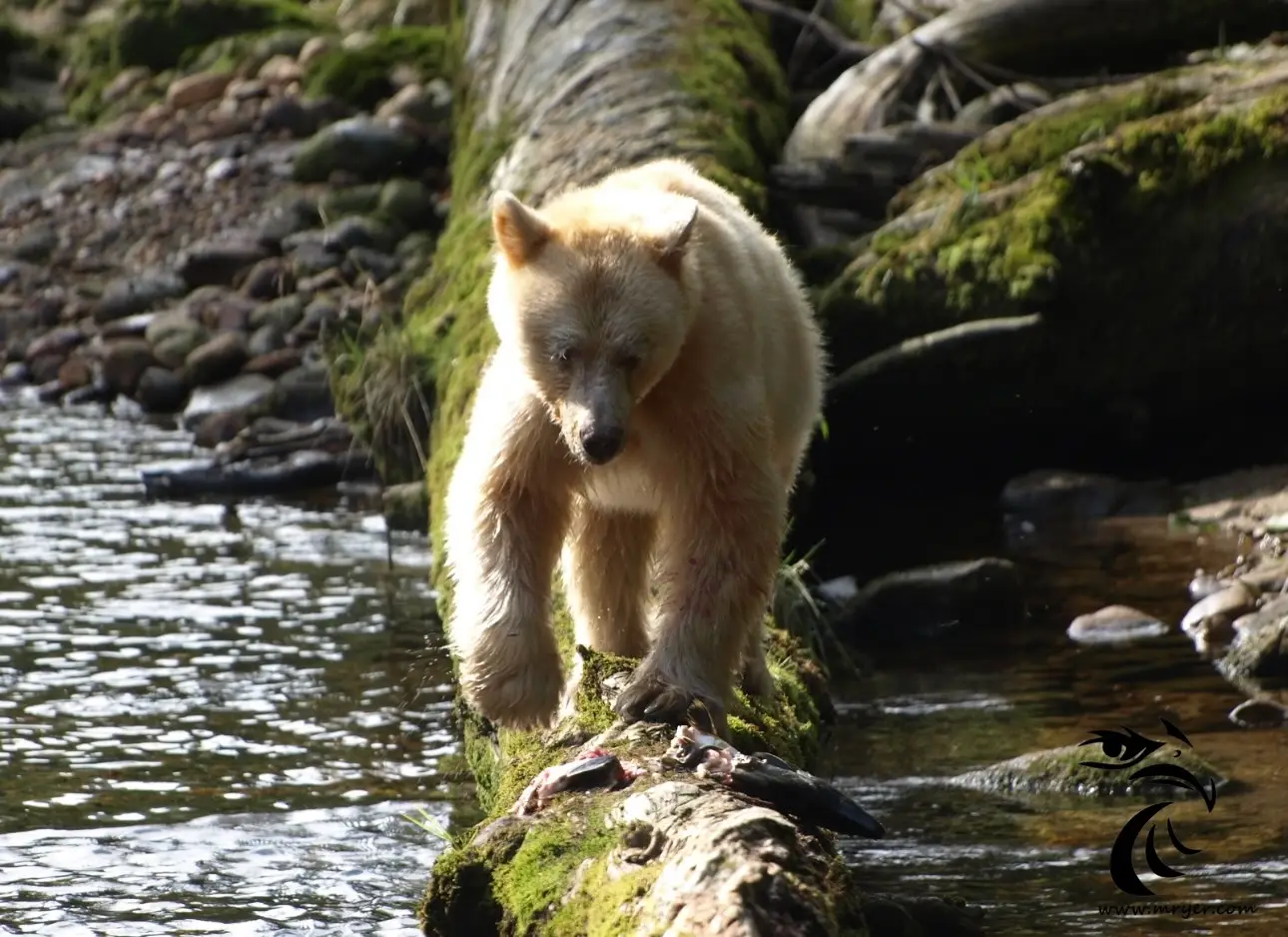
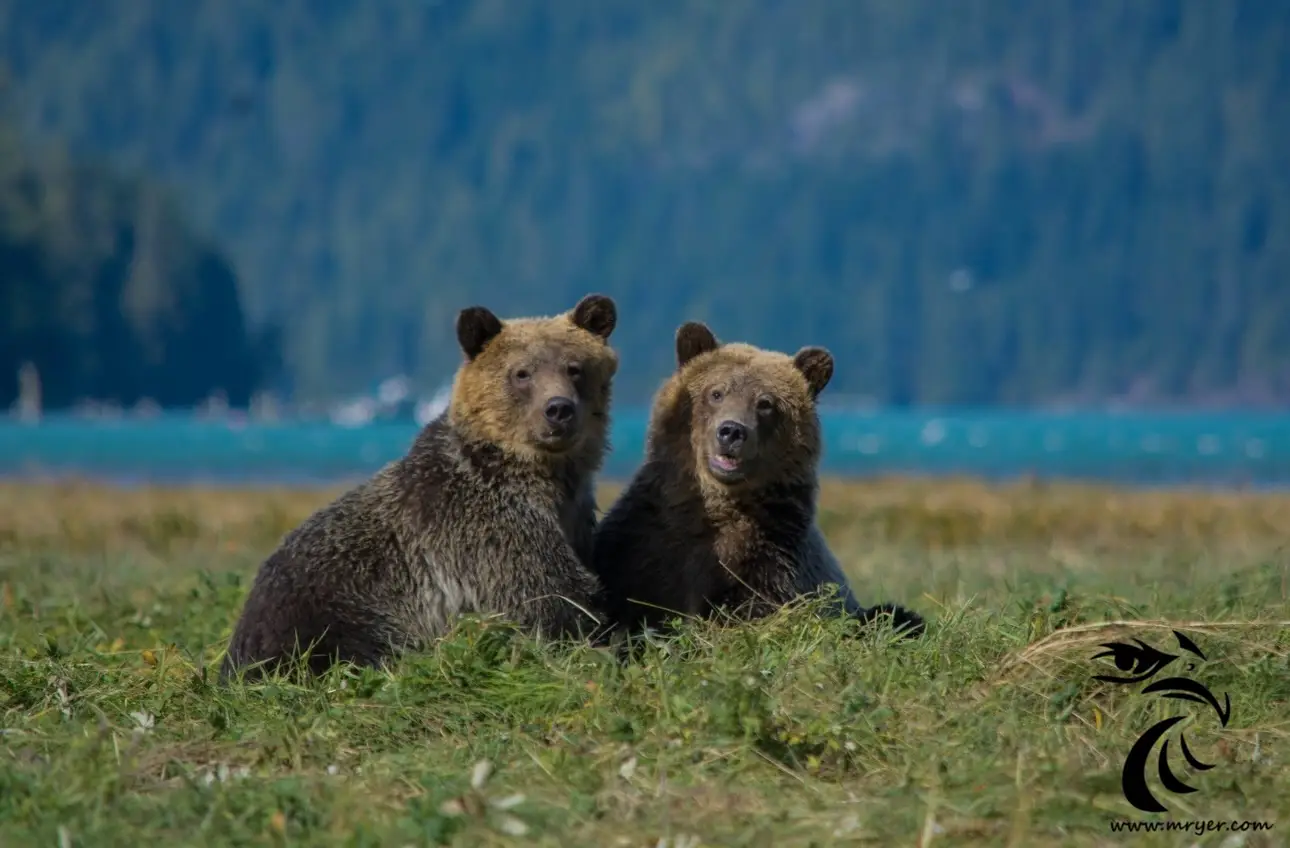
(Bear photographs courtesy of Nature Photography by Martin Ryer.)
Keep a “Bare” Campsite
Keep all bear attractants well away from your tent site including food, garbage, fish guts, toiletries, and scented personal care items such as toothpaste, deodorant, lip balm, soap, sunscreen, and bug repellent. Cooking and cleaning should be done away from your tent, and all food scraps should be packed out. Clean fish far from camp and below the tideline, so scraps wash away.
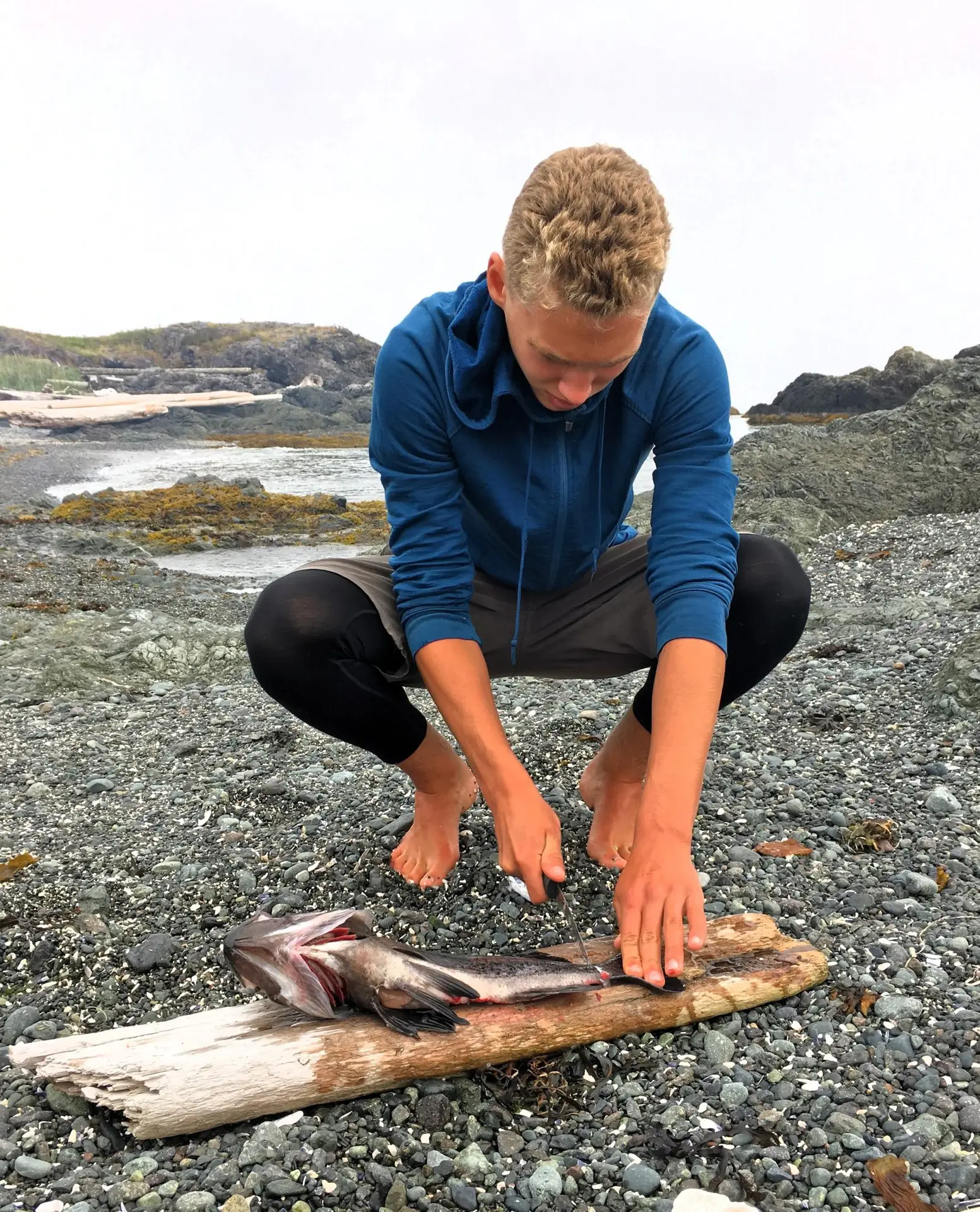
Store food and toiletries in a bear-proof food cache, and avoid leaving food or trash unattended. Bears are intelligent and learn new food sources fast. If a bear receives human food even once, it may attempt to loot other packs or sea kayaks for food, ultimately leading to the bear being destroyed. Remember the saying, “A fed bear is a dead bear”.
While paddling in wilderness areas without bear lockers, kayakers are often faced with a dilemma: whether to hang heavy food bags out of reach of bears, or seal well-wrapped food in waterproof and odour-proof stuff sacks, inside a kayak hold, with neoprene and fibreglass hatch cover securely strapped on top? We usually do the latter in areas where food lockers aren’t available. So far, it has protected everything against rodents and raccoons, and we haven’t attracted any interest from bears. A third option is to store food in bear canisters. These have long been popular with river rafters and canoeists and are now mandatory in many US national parks. Most are too large to be used by sea kayakers, but smaller versions that fit inside a kayak hatch are now available at many outdoor retailers.
Unfortunately, there is no one-size-fits-all answer for food storage. If a bear attacks you, there is also no one-size-fits-all answer for whether to curl up in a ball and play dead or fight back with everything you’ve got. As with so many things, it depends.
We paddle mainly in areas with either no bears or black bears. We take comfort from the fact that with over 750,000 black bears in North America, there is an average of only 11 attacks on humans and one human death per year.
The statistics for grizzly encounters in places like Yellowstone or Glacier National Park and for brown bears in Alaska are not as comforting. Grizzlies are common on the central coast and have recently been seen on northern Vancouver Island. This BC Marine Trails trip report describes an encounter where a grizzly takes a sandwich from a kayak and doesn’t seem bothered by pepper spray.
Not every bear encounter has a happy ending. When we paddle in higher-risk areas, we favour the safest possible option — even if it is more work — to avoid unhappy endings like the one described below.
Q: How did they know it was a brown bear that killed him?
A: They recovered his camera. The last pictures were of the brown bear. Apparently, he was taking pictures of it just before it attacked him.
From Glacier Bay Discoveries by Will Nordby in Seekers of the Horizon: Sea Kayaking Voyages From Around the World
Avoiding Encounters
Stay vigilant while walking around. No earbuds — you need all your senses. Be aware of bear attractants around you, such as berries or spawning fish. Stay on designated trails. Watch for bear tracks or scat. Use your voice or sing loudly, especially near running water or on windy days when sounds may be masked. Walk in groups if possible. In Yellowstone Park, 91% of bear-related injuries have occurred when hikers travel in ones or twos, while only 9% occurred with groups of three or more. Bear bells may not be heard over wind and waves and fail to identify you as a human, so it’s better to use your voice.
What To Do If You See A Bear
If you see a bear, don’t approach it for photos. If the bear is aware of you but not threatening, remain calm. Gather your group and make sure everyone is present. Talk in a deep, assertive voice to make the bear aware that you are human. Back away slowly, leaving an open escape route for the bear. Wait to give it time to leave the area.
Don’t run, as bears are much faster than you. Like many wild animals, they have a natural chase instinct that can be triggered by running away. Don’t climb a tree, as bears are expert climbers. Avoid cubs — mom is likely close by and very protective. If you spot a carcass, stay away — bears can be protective of their food. A bear standing on two legs isn’t getting ready to attack — it’s just trying to get a better look at you.
A short blast of an air horn may scare off a bear. Bear bangers are not recommended: they may scare the bear toward you, and they are a fire hazard. Most experts recommend bear spray as the best deterrent. Its greatest advantage may be that it gives you the courage to stand your ground while giving the bear a chance to go away.
Bear Spray
In all our years of sea kayaking and hiking, we’ve never once needed to use bear spray. We once had fun practicing with an expired can of bear spray in pretend scenarios on a group trip with teens. To do this, you must be in a private place with no innocent bystanders downwind. Practice with live bear spray helped the teens become more confident and better able to remain calm in bear encounter scenarios.
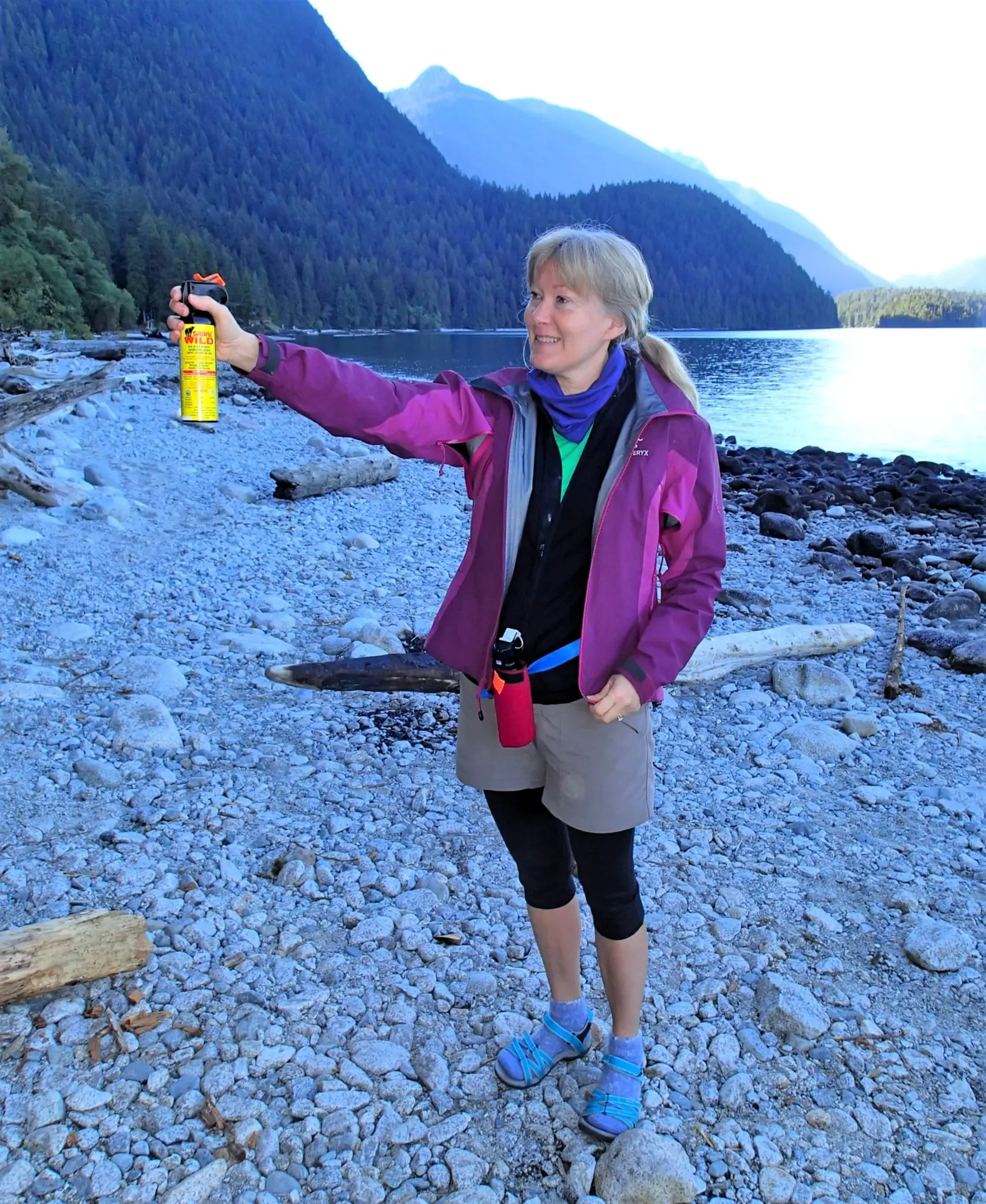
Keep your bear spray in an accessible location, not buried in your pack, tent, or kayak hatch. Familiarize yourself with its mechanism and practice pulling it out of the holster and using it before your trip. In the event of an encounter, our canister of bear spray instructs users to:
Aim at the face and eyes of the bear. Press trigger for three seconds to create a barrier of spray between you and the bear. Stop to evaluate the impact of wind or other factors and adjust your aim if needed before spraying again. The maximum effective range is 9 – 10 meters. Spray is most effective at short range.
A study of Alaskan bear encounters found that 98% of those who used bear spray were uninjured by the bear, and the remaining 2% received only minor injuries that required no hospitalization. Bear spray deters cougars and wolves too. Our most serious wildlife encounter occurred when four wolves pinned our family of two adults, two young children, and a stray dog against the ocean. Since this “wolf incident,” Julee always wears a can of bear spray around her waist in the wilderness, even on a wide-open beach.
A canister of bear spray strapped around your waist serves double duty both as protection and as a super-cool fashion accessory. If you carry bear spray with you, there’s only a tiny chance you’ll need it to spray an actual bear, but a 100% chance you’ll look fabulous!
Putting it All Together: Who’s Got The Bear Spray?
On a paddling trip to Rugged Point when our boys were 14 and 12, our family decided to take an afternoon walk to Sandpiper Creek for drinking water, and then continue further south to bathe in the deeper water at Kapoose Creek. A large yellow sign at the Rugged Point campsite warned of “Cougars In The Area!”
When we got to Sandpiper Creek, the boys asked to stay there instead of joining us for the swim. They wanted to re-engineer the creek outflow with dams made from rocks and sand.
“Do you think the boys are far enough away from the forest?”, Julee asked as we prepared to leave the boys behind. “Is it safe leaving them here?”
“Oh sure,” I assured Julee, who by then always wore a can of bear spray for our beach walks. We always see a bear or bear sign at Kapoose Creek, so she knew we had to bring it. I had never seen bear sign at the smaller, more densely wooded Sandpiper Creek.
Somewhat reluctantly, Julee joined me to walk onward to Kapoose Creek by ourselves. Before departing, I left a folding knife with our older son J in case the cougar warnings were accurate. I didn’t think to tell anyone that I had the second can of bear spray attached to my day pack. This felt like a sensible precaution because Julee and I often split up on our walks and I wanted to be ready in case I encountered a bear or cougar while on my own.
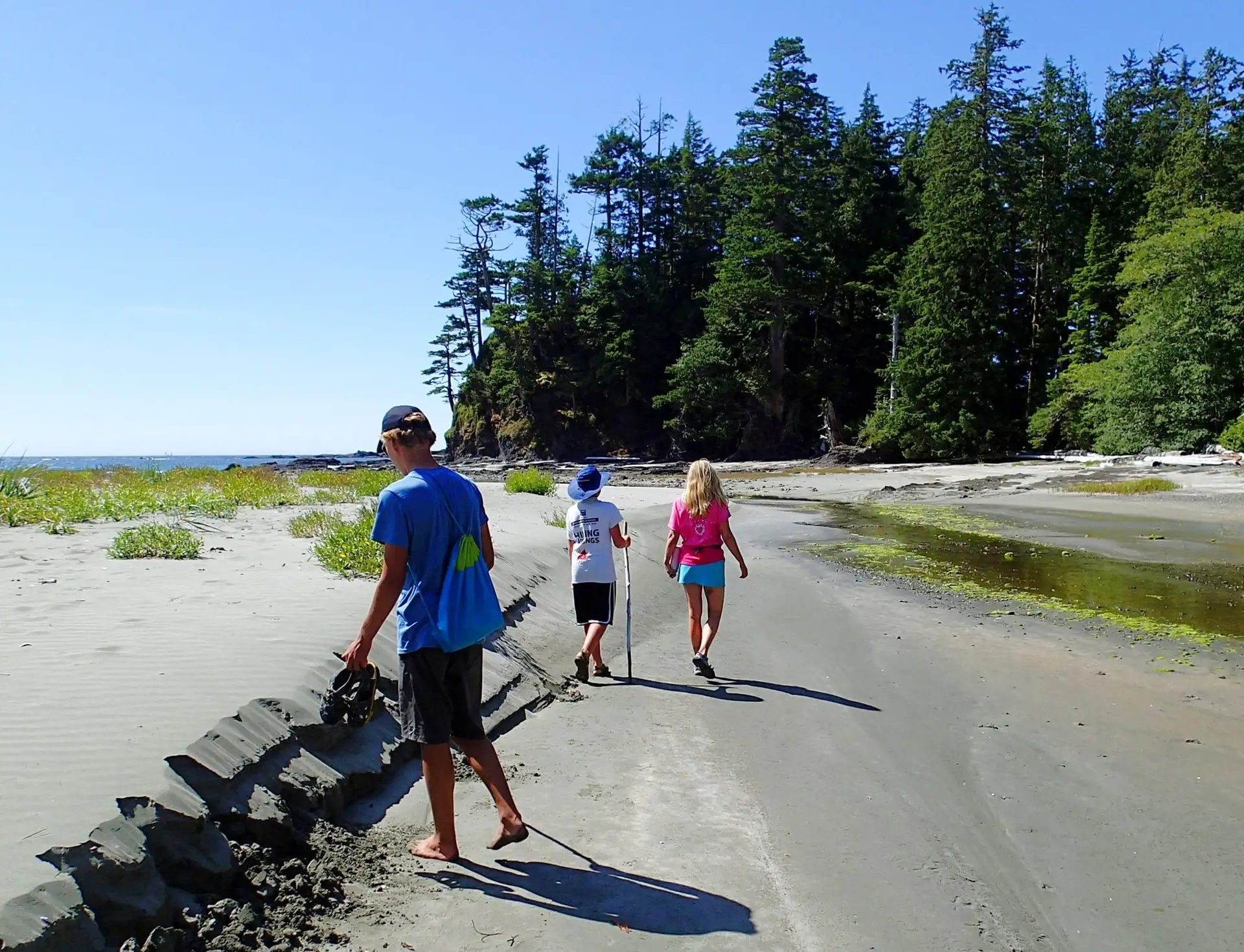
Julee and I enjoyed an uneventful walk and a lovely dip in Kapoose Creek.
The boys, however, had a very different experience. We’d no sooner left them “far enough from the forest” when they decided to move their creek engineering project upstream, much nearer to the woods.
Younger brother R moved to this new location while his older brother J finished off his work downstream, closer to the ocean. Then R heard something move in the bushes. He stopped his work to face the sound and called to his brother that something was there. Wanting to slowly step back, R looked over his shoulder to check his footing (it would be a bad time to fall!). Instantly, another rustle. Step back, turn head, rustle: the pattern repeated for several more steps.
Poor brave, undefended R theorized that this pattern was consistent with a cougar preparing to pounce when his back was turned.
J, meanwhile, came up from the beach to stand with his brother, one small pocketknife in hand, well aware of what a sorry weapon that could turn out to be if the cougar charged.
The pair of boys were greatly relieved to see, not a cougar, but a black bear emerge from the brush. It ambled along the forest edge without so much as sending them a sideways glance.
Shortly afterward, the boys were reassured when another family of kayakers came strolling around the corner towards them. J and R promptly warned them about the bear while seizing the opportunity to better arm themselves with sticks.
Needless to say, Julee and I were very proud of our boy’s calm, measured response to the bear’s approach. Since then, I’ve been much more careful about distributing cans of bear spray on our outdoor adventures.
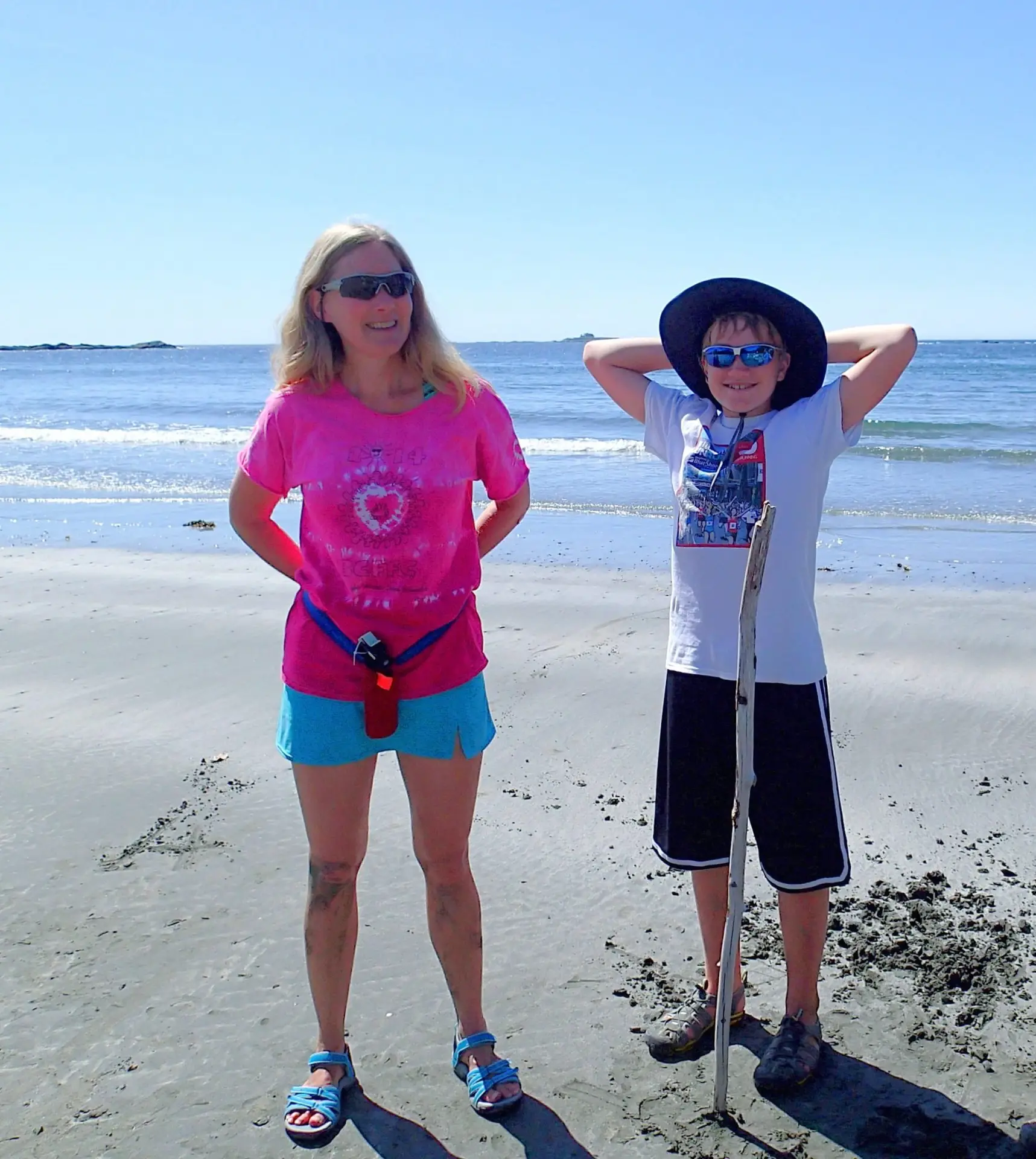
As you kayak through bear country, we hope your bear encounters, like ours, are benign for both you and the bears, and that your wild bathing leaves you feeling fresh, clean, and alive!
